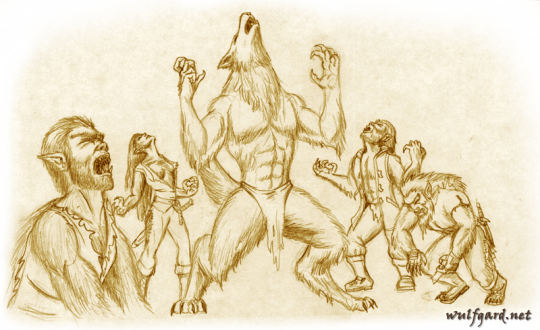What IS a Werewolf?
What is a werewolf, anyway? How do you define one? Do they have to fall into a certain range of requirements?

The answer is at once simple and complicated. The simple answer is…
A werewolf is any person who can turn into a wolf or wolf-man/man-wolf hybrid, willingly or unwillingly, in a true physical (not illusionary) transformation.
That’s it. Those are all the requirements that need be met. But there are more details besides this, as not everyone/every creature that can turn into a wolf counts as a “werewolf.”
As you know, there are many means of becoming a werewolf. It’s generally considered an innate ability, thanks to birth, a curse, a blessing, a ritual, or in many modern works often some kind of disease/infection (often in itself technically a kind of curse; note that lycanthropy was not a disease in folklore). In folklore, it can often happen via an artifact as well, such as a cloak, belt, or ring.
Plenty of modern pop culture also makes lycanthropy into a disease, an experiment, or even some kind of alien thing. Like Man-Wolf in the Spider-Man comics, who was turned by the Moonstone artifact literally from the moon. We also got Capwolf out of the various Marvel werewolf storylines, so that was totally worth it (no irony intended; I absolutely adore Capwolf – the original one, anyway).

So as you can see, werewolves come in many varieties. Some werewolves can control themselves, some cannot (especially in modern fiction); the ability to control oneself, or lack thereof, doesn’t make them any more or less a werewolf. And if you have a “wolf shifter” then they are almost certainly technically still a werewolf, whether they like it or not.
Another element crucial (or at least once crucial) to werewolves is that they retain most, all, or at the very least some of their intelligence. A lot of werewolves in pop culture don’t do this; lots of pop culture werewolves are blithering morons, so stupid they will run headlong off cliffs or into walls or throw themselves on something repeatedly until they die, but having human or near-human intelligence used to be a mark of a werewolf. I personally think it really should be again.
Now for another question: can werewolves include nonhumans? Is Sonic Unleashed a werewolf?
The answer is yes, although they can’t really be called “werewolves” anymore by the etymological definition. Sonic in Sonic Unleashed is indeed a werewolf (and no, he is not a werehog; that would mean he is a man turning into a hog. He is already a hedgehog, and he has nothing to do with humans except being humanoid and anthropomorphic). He even turns under moonlight in the “Night of the Werehog” short, so he’s given even more obvious werewolfish even qualities beyond looking… well, more wolfish than many Hollywood werewolves.

I personally find nonhuman werewolves outside a cartoony situation/cartoon characters, like Sonic, immensely strange and often rating high on the wtf scale, but to each their own. With this I am mostly referring to things like argonian werewolves in Elder Scrolls. I can’t deal with lizard-people and cat-people being werewolves – I mean, just, what? But yes, technically that’d still make them werewolves of a sort (even if not werewolves because they aren’t humans).
So is there anyone who can turn into a wolf or wolf hybrid who ISN’T a werewolf?
The answer is yes, absolutely.
What’s the difference? Werewolves do not include sorcerers who are turning into a wolf through an illusionary magic temporarily granted from an outside source.
This is mostly the concern of folklore. For instance, werewolf scholars too heavily took into the account the trial of Peter Stubbe as an important part of werewolf studies, but it was not. Stubb was a sorcerer, and was recognized as such during his own time. There are specified differences, even in folklore, between a witch and a werewolf.
Witches and ritualists would turn into all kinds of animals, including wolves, but there were distinct differences between them and a werewolf. Firstly, witches do not have a tail when they turn into an animal; werewolves do. This was specified across multiple sources in folklore, believe it or not.
Secondly, witches do not truly become wolves. Although their strength, speed, etc., is often increased, the guise is still illusionary and not considered a “true” transformation, like a werewolf. It can be easily dispelled and can be hard to maintain. Werewolves do not have this weakness (or is it a luxury?).
Thirdly, witches did not turn into wolves because of any special significance in relation to that particular animal. Werewolves had their relation to wolves for a very specific, thematic/poetic reason. It had depth and meaning, in every bit of folklore, tale, and lai. Witches just turn into a variety of animals that happen to include wolves.
Werewolves also come in many different appearances! Both in folklore and popular culture. This generally includes wolves, hybrids that are more wolf than man, and hybrids that are more man than wolf. No, it does not include big ape-gaited hairless mangy monstrosities with long, droopy ears and, often, short flat muzzles like we see so often today.
Not all werewolves turn under the full moon. Some can control themselves, some can’t. Not all werewolves turn into just wolves, or hybrids, or have any specific level of control over these forms and whatnot. Not all werewolves are capable of spreading their curse through any means (in fact, in folklore, generally, really are).
So now you know what a werewolf is!